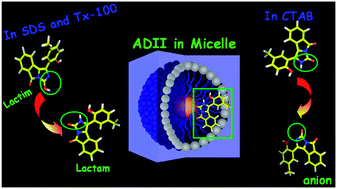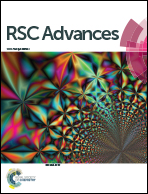Differential modulation of lactim–lactam tautomerism process of an isoindole fused imidazole system in three different micellar assemblies of varying surface charge: a spectroscopic approach to various photophysical properties†
Abstract
This article describes a detailed characterization of the binding interaction of a pharmaceutically important isoindole fused imidazole derivative, namely 1-(2-hydroxy-5-methyl-phenyl)-3,5-dioxo-1H-imidazo-[3,4-b] isoindole (ADII) with biomimetic micellar assemblies of varying surface charge using steady state absorption, emission and time resolved emission spectroscopy. The studied molecule ADII is known to exhibit an intramolecular proton transfer process through a four member hydrogen bonding system resulting in a lactim lactam isomerisation process. Upon interaction with the micellar environment, a significant change in the absorption and emission profiles of ADII is observed due to differential modulation of inherent proton transfer in the three studied ionic and non-ionic micellar environments. The micropolarity measurement and fluorescence quenching experiments have been performed to evaluate the binding location of the probe (ADII) in the three micellar assemblies. The differential binding affinity of the probe with the micelles also results in different rotational relaxational motion of the probe within the encapsulated microheterogeneous environments.


 Please wait while we load your content...
Please wait while we load your content...